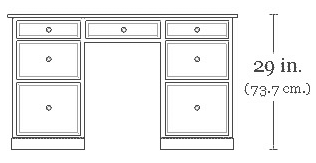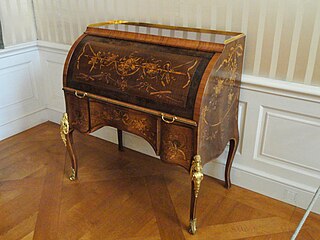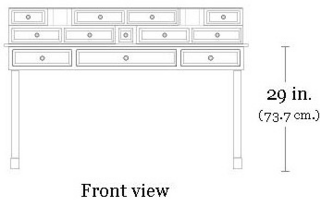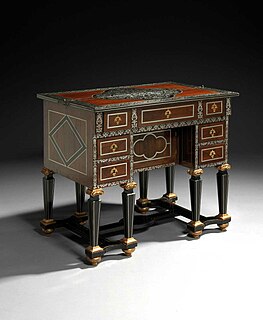
A desk or bureau is a piece of furniture with a flat table-style work surface used in a school, office, home or the like for academic, professional or domestic activities such as reading, writing, or using equipment such as a computer. Desks often have one or more drawers, compartments, or pigeonholes to store items such as office supplies and papers. Desks are usually made of wood or metal, although materials such as glass are sometimes seen.

A rolltop desk is a 19th-century reworking of the pedestal desk with, in addition, a series of stacked compartments, shelves, drawers and nooks in front of the user, much like the bureau à gradin or the Carlton House desk. In contrast to these, the compartments and the desktop surface of a rolltop desk can be covered by means of a tambour consisting of linked wooden slats that roll or slide through slots in the raised sides of the desk. In that, it is a descendant in function, and partly in form, of the cylinder desk of the 18th century. It is a relative of the tambour desk, whose slats retract horizontally rather than vertically. The rolltop desk was re-invented by Jacob Alles in Jasper, Indiana in 1879. "About 1760 Jean-François Oeben designed a new type of bureau: the original rolltop desk. The writing area can be covered by a shutter made of flexible slats, which is rolled round a cylinder hidden behind the top tier of drawers. In the Château de Versailles is found the most famous example of this type of desk, the "bureau du roi," which was begun by Oeben in 1760 and finished by Riesener. Riesener made several rolltop desks; the one for Thierrry de Ville d'Avray indicates that the Louis XV style was not yet regarded as outmoded in the 1780s".

A pedestal desk or a tanker desk is usually a large, flat, free-standing desk made of a simple rectangular working surface resting on two pedestals or small cabinets of stacked drawers of one or two sizes, with plinths around the bases. Often, there is also a central large drawer above the legs and knees of the user. Sometimes, especially in the 19th century and modern examples, a "modesty panel" is placed in front, between the pedestals, to hide the legs and knees of the user from anyone else sitting or standing in front. This variation is sometimes called a "panel desk". The smaller and older pedestal desks with such a panel are sometimes called kneehole desks, and were usually placed against a wall.
The portable desk has not one but many forms. It can be seen as an ancestor of the portable computer, and the modern laptop could be considered an atavistic grandchild of the 19th-century lap desk.

The cylinder desk is a desk that resembles a Bureau Mazarin or a writing table equipped with small stacked shelves in front of the user's main work surface, and a revolving cylinder part that comes down to hide and lock up the working papers when the desk is not in use.

A writing table has a series of drawers directly under the surface of the table, to contain writing implements, so that it may serve as a desk. Antique versions have the usual divisions for the inkwell, the blotter and the sand or powder tray in one of the drawers, and a surface covered with leather or some other material less hostile to the quill or the fountain pen than simple hard wood.

A bureau à gradin is an antique desk form resembling a writing table with, in addition, one or several tiers of small drawers and pigeonholes built on part of the desktop surface. Usually the drawers and pigeonholes directly face the user, but they can also surround three sides of the desk, as is the case for the Carlton house desk form. A small, portable version is a bonheur du jour.

The bureau Mazarin is a 17th-century desk form named more or less in memory of Cardinal Mazarin, who was the Chief minister of France from 1642 to 1661. It is the earliest predecessor of the pedestal desk and differs from it by having only two tiers of drawers or three tiers of rather small drawers under the desktop surface, followed by eight legs supporting the whole. Also, the bureau Mazarin has cross braces between the legs, forming two Xs or two Hs on each side.

In cabinetry, the bargueño is a form of portable desk, made up of two chests, the bottom one usually having drawers and the top one having a hinged desk surface which also serves as a side-mounted lid. It is basically a chest or box with one of the side panels, rather than the top panel, serving as a fold-out writing surface. The interior of the desk is equipped with small drawers, pigeonholes, etc., for storing papers and supplies. The bargueño has also been used for sewing or as a jewel chest.
The fire screen desk is a very small antique desk form meant to be placed in front of a fireplace to keep a user's feet warm while he or she is stationary while writing. This kind of desk was very popular in prosperous homes in Europe during the 18th century and slowly disappeared during the 19th, with the gradual introduction of stoves and central heating.

Jean-Henri Riesener was a famous German ébéniste (cabinetmaker), working in Paris, whose work exemplified the early neoclassical "Louis XVI style".

A Carlton House desk is a specific antique desk form within the more general bureau à gradin form. This form of desk is supposed to have been designed in the 18th century for the Prince of Wales by George Hepplewhite. It is named after Carlton House, which was at the time the London residence of the Prince, and sometimes is also known as a Carlton House writing table.
The secretaire en portefeuille is an antique desk form which is usually mounted on rollers at the end of four jutting legs. The legs in turn support what appears as an oversize vertically mounted wooden pizza box. This is a cabinet a few inches thick, with barely enough space in it for the raised desktop surface and a few pens and sheets of paper disposed vertically. It is also called a "Billet doux".

The Bureau du Roi, also known as Louis XV's roll-top secretary, is the richly ornamented royal cylinder desk which was constructed at the end of Louis XV's reign, and is now again in the Palace of Versailles.

A Games table desk is an antique desk form which combines the type of surface required for writing with a surface etched or veneered in the pattern of a given board game. It also provides sufficient storage space for writing implements and a separate space for storing game accessories such as counters. It is often called a "games table" or game table, which leads to confusion with pieces of furniture which are built specifically for gaming only, with no intention or provision for use as a desk.

Rocaille was a French style of exuberant decoration, with an abundance of curves, counter-curves, undulations and elements modeled on nature, that appeared in furniture and interior decoration during the early reign of Louis XV of France. It was a reaction against the heaviness and formality of the Style Louis XIV. It began in about 1710, reached its peak in the 1730s, and came to an end in the late 1750s, replaced by Neoclassicism. It was the beginning of the French Baroque movement in furniture and design, and also marked the beginning of the Rococo movement, which spread to Italy, Bavaria and Austria by the mid-18th century.

The furniture of the Louis XV period (1715-1774) is characterized by curved forms, lightness, comfort and asymmetry; it replaced the more formal, boxlike and massive furniture of the Style Louis XIV. It employed marquetry, using inlays of exotic woods of different colors, as well as ivory and mother of pearl.

Louis XIV furniture was massive and lavishly covered with sculpture and ornament of gilded bronze in the earlier part of the personal rule of King Louis XIV of France (1660–1690). After about 1690, thanks in large part to the furniture designer André Charles Boulle, a more original and delicate style appeared, sometimes known as Boulle Work. It was based on the use of marquetry, the inlay of piece of ebony and other rare woods, a technique first used in Florence in the 15th century, which was refined and developed by Boulle and others working for the King. Furniture was inlaid with thin plaques of ebony, copper, mother of pearl, and exotic woods of different colors in elaborate designs.

Louis XVI furniture is characterized by elegance and neoclassicism, a return to ancient Greek and Roman models. Much of it was designed and made for Queen Marie Antoinette for the new apartments she created in the Palace of Versailles, Palace of Fontainebleau, the Tuileries Palace, and other royal residences. The finest craftsmen of the time, including Jean-Henri Riesener, Georges Jacob, Martin Carlin, and Jean-François Leleu, were engaged to design and make her furniture.















